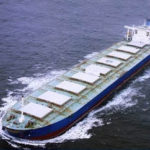Trade Tensions Spill Over Dry Bulk Markets

QThe dry bulk market is not immune to trade tensions that have been brewing since early 2025. In its latest weekly report, shipbroker Intermodal said that “Beijing’s move to halt BHP-linked Australian iron ore cargoes, coupled with tariff friction hampering US agricultural sales to China, particularly soybeans, has accelerated a realignment that was already underway. combining growing scale, reliability and diplomatic alignment. What may seem tactical in the areas of iron ore and soybeans are, in fact, part of a broader and longer-lasting shift in China-Brazil relations that now encompasses diplomacy, investment and standard-setting, and the knock-on effects will impact global trade and shipping flows for years.”
According to Yiannis Parganas, Head of the Research Department at Intermodal, “when it comes to soybeans, the rotation is undeniable. Trade uncertainty and tariff noise have pushed Chinese buyers to lean more heavily on Brazilian products, whose production capacity, cost competitiveness and logistics are continuously improving to meet this kind of increased demand. Brazilian exporters have adjusted their logistics chains from farm to port to prioritize China during peak shipping times, while Chinese crushers prioritize consistency and volume. The result is a structural bias against Brazil that goes beyond the turn of a single season. Meanwhile, the BHP ban increases the impact of dependence on Australian ore at a time when Beijing is exploring ways to gain greater control over commodity trade through price influence, currency diversification and a wider choice of sources. Regardless of how this ban develops, the main conclusion is clear. Diversify supply sources, strengthen reliable partnerships and reduce exposure to policy risks.”

Source: Intermodal
The shipping broker added that “the logic is in line with political relations that are currently at their strongest point in decades. High-level engagement has expanded well beyond ceremonial visits, developing into a working architecture built on coordinated positions in multilateral forums, a shared vocabulary on reforming global governance, and practical collaboration within BRICS. Both sides frame this as a partnership that respects sovereignty that offers predictability amidst unstable conditions. geopolitics. In practice, this means faster approvals for Brazilian agricultural exporters as Washington implements stricter measures, and widening pathways for Chinese industrial investment in Brazil even as Brasília investigates dumping on certain manufactured goods. The direction of travel is consistent. Less dependency on one external party and more room for deal-making South-South”.

“Economically, the relationship is broadening. Commodities are still the mainstay, soybeans, iron ore and crude oil are still the cog in the wheel, but the mix continues to change. The share of Brazilian manufacturing in exports to China is increasing, Chinese capital is flowing into electric vehicles, batteries, telecommunications and logistics in Brazil, and both governments are testing new standards in sustainability. Cooperation on environmental traceability and certification of beef and soy beef is not window dressing green; it is a market access strategy designed to future-proof trading against the next wave of ESG-driven headwinds. The more both parties agree on data, measurement and labeling, the more difficult it is for third-party politics to disrupt the underlying flow,” Parganas said.
He added that “for shipping, this is not a side note, it is a feature embedded in the new balance. Longer average freight from Brazil to discharge ports in China expands ton-miles in both dry and wet segments. In dry bulk, replacing Brazilian ore with Australian tons will widen the Capesize cycle, tighten Atlantic tonnage at the margin, and increase the risk premise of weather and congestion around important Terminals Brazil. In agriculture, growing dependence on Brazil is reshaping Panamax and Supramax employment patterns, sustaining trans-equatorial flows even beyond their normal peaks. On the wet side, the maturing Brazil-China crude pipeline continues to be a core artery of VLCCs along the Middle East-Asia, providing owners and charterers with hedging options when Middle East OSPs, Russian rerouting, or policy turbulence shifts the economy relatively”.

Source: Intermodal
“None of this is linear. Brazil cannot replace every molecule of Australian ore overnight; Chinese mills will continue to adjust blending strategies based on quality and cost. In soybeans, Brazil’s internal logistics, from onshore storage to port arrangements, will remain an active variable at each harvest. Meanwhile, crude oil’s trajectory will depend on the pace of pre-salt project development, maintenance schedules and price differentials relative to Atlantic and Middle Eastern alternatives. But the strategic overlay is more important than any quarterly headwinds. China is engineering resilience by attaching itself more closely to partners with complementary capabilities and converging diplomatic interests; Brazil is turning geopolitical friction into commercial opportunity, while carefully diversifying so it doesn’t stick to just one buyer,” Intermodal analysts concluded.
Nikos Roussanoglou, Worldwide Hellenic Shipping News
